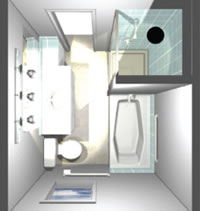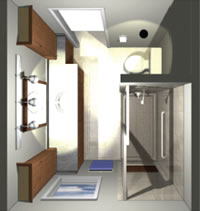Problem Solvers
Bariatric Baths: An Eye On Design
How one company aims to offer bariatric patients bathrooms that are safe — and attractive.
- By David Kopf
- Oct 01, 2010
Providing bariatric bath safety is, of course, focused around the critical aspects involved in ensuring that heavier patients without problems. Various elements of the bathroom must be durable enough to stand up to their weight, grab bars and other hand holds must be provided to minimize the risk of any slip or fall, and the bathroom must be arranged in such a way as to help the patient more freely move within its confines.
However, the one element that is typically missing from most bariatric bath safety projects is appeal. While many manufacturers of bath safety equipment strive to give their DME appealing designs, at the end of the day, bariatric patients do not enjoy the plethora of attractive interior design options they might find at their local home store. The result is that while a bariatric patient’s bath is safe, they might not necessarily like it, or feel proud of it.
And from a homecare standpoint, that is a significant no-no. If the goal is to help patients live at home and lead an independent life, then they must enjoy their home in full. Otherwise, the objective to provide safe, independent living remains half fulfilled.
A New Approach
Well, one company aims to change that. Sacramento, Calif.-based Bathroom Design Experts (www.bathrroomdesignexperts.com) offers experienced interior design services to bariatric and other homecare patients that are geared to build not only a safe bathroom for patients, but one they can be proud of. (Bariatrics is Bathroom Design Experts’ main focus.)
“We do bathroom designing so that people can have a visual of what their bathroom is going to look like,” says Cynthia Shull, president and owner of Bathroom Design Experts (bathroomdesignexperts.com). “I do the CAD drawings to let people see what the changes are going to be and what it looks like now. Sometimes they have a visual of issues as to what it will look like, so I do a ‘before and after.’”
In terms of process, working with Bathroom Design Experts is akin to working with a standard interior designer. The patient can confer with Shull in person or over the phone and Shull develops a plan for what the bathroom should be. Once the patient approves the plans, Shull provides a complete package with designs, specifications and outlines of necessary DME that the patient can then give to his or her general contractor.
Shull says she also makes sure that the patient understands all the products that she is going to incorporate into the remodeling project for them. And this is where Shull’s expertise comes in, as she can determine products that will mesh well with her interior designs.
“Whatever they need, I make sure they have a complete list of what I recommend for their particular requirement,” she says.
Designing safe bathrooms for bariatric patients that are also attractive can prove an interior design challenge, Shull says. A balance must be struck between the cleanliness of the design and the functionality and safety of the room. Also, she must ensure ease of movement throughout the room, which can be tough if the patient’s bathroom is a smaller space.
“For example, one of the things I like to do is recess the toilet back into the wall, and there are ways I can do that without interrupting the structure of the wall,” she say. “This gives them more space to get into and out of the toilet area. And a lot of times that results in giving them more room to get into and out of the tub area, so sometimes just a few inches can mean so much.”
While redesigns can get somewhat involved, Shull says she can usually work within the confines of the bathroom walls, without having to expand. “Each bathroom is different, but usually I can take standard five-foot-wide by 10-foot-long room and generally increase the access space available by at least six inches, if not more,” Shull says.
Unique Solutions
Shull says her designs take into account the special balance issues bariatric patients must content with. So, for instance, storage areas and shelves tend to be placed at arm height, so that a bariatric patient can reach straight across, rather than up or down.
Another frequent consideration is that the design of the bathroom has to be safe and accommodate the patient’s needs, but it also has to be usable by guests and other people living in the home. If a patient truly wants to enjoy his or her home, then that means being able to share it with guests. So the designs and DME Shull selects keep that consideration in mind, as well.
Sometimes, it all comes down to hiding things in plain sight. For example, a patient might need multiple grab bars in the bathroom, but these an easily be disguised as towel bars when guests are over. Moreover, Shull says she has spent years accumulating product knowledge on such items as grab bars so that she is aware of solutions that are not only safe for bariatric patients, but decorative, as well. “People don’t even realize they’re there, but someone who needs that steadiness available to them, they’ll know they’re there,” she says.
Bathroom Makeover


In this before and after set of designs, Bathroom Design Experts created a CAD drawing of the current bathroom (left). The bathroom is cramped and awkward for use. The doorway is small and the wall between the shower and tub area encroaches into the room, leaving a very narrow passageway.
In the Bathroom Design Experts redesign (right), opening up the doorway into the bathroom and reducing the length of the wall between the toilet and shower gives a bit more space for passing. Also, moving the toilet into the shower area and removing the “never-use” tub makes the bathroom more functional. The fl ip down seat offers 450 lbs weight capacity, but also leaves the shower area roomy. Additional storage cabinets are easy to reach for everyone.
This article originally appeared in the October 2010 issue of HME Business.
About the Author
David Kopf is the Publisher HME Business, DME Pharmacy and Mobility Management magazines. He was Executive Editor of HME Business and DME Pharmacy from 2008 to 2023. Follow him on LinkedIn at linkedin.com/in/dkopf/ and on Twitter at @postacutenews.